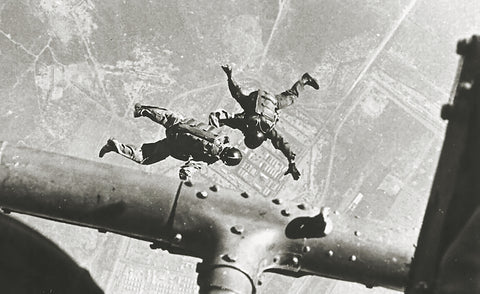
Their Existence Was Denied by the US Government. Their Mission Photos Proved Otherwise
Author John L. Plaster’s SOG: A Photo History of the
Secret Wars gives readers a fascinating look at men who served in this top-
secret unit, recounting their heroism and courage as well as insights into
covert operations.
Special operations missions are the stuff of legend. Shrouded in secrecy, these dangerous assignments are fit to be undertaken only by warriors who have proved they can excel at what others find impossible. Sometimes secrecy can give rise to myths. But there are no myths in John L. Plaster’s fine book, SOG: A Photo History of the Secret Wars —the incredible stories of heroism, sacrifice, and daring are all based firmly on fact and enriched with source materials provided by the men themselves.
Consisting of volunteers from elite special operations units across the spectrum of the U.S. military—such as the Army Green Berets, Navy SEALs, and Marine recon units—the Military Assistance Command, Vietnam-Studies and Observations Group (known by its acronym SOG) was an ultra-secret force that was practically invisible to all.
Reporting directly to the Joint Chiefs of Staff and even at times the president, SOG left zero public footprint and performed clandestine missions that remain unknown to many today. Despite the challenges of chronicling the history of this unit, Plaster’s book provides a wealth of information about the SOG experience during the Vietnam War, using more than 700 photos snapped “in wartime by the very men who performed SOG’s amazing missions.” This portfolio contains a selection of those rare images, which Vietnam magazine is pleased to share with readers courtesy of Casemate Publishers.
The book features an array of remarkable and striking images. No less striking and remarkable are the stories of personal bravery that accompany them. “I’ve sought to humanize and make real these phenomenally courageous men, to help readers understand in our image-conscious era that it’s what’s inside such extraordinary warriors that makes them special,” writes Plaster in his introduction. It is a noble mission and one that the author has accomplished with excellence.
This story appeared in the 2023 Summer issue of Vietnam magazine.
Members of an SOG reconnaissance team from Command and Control Central (CCC)
based in Kontum, South Vietnam, scale retractable ladders in midair during an
emergency extraction from Laos. Rapid extractions saved many SOG men who were
being threatened by enemy forces.
SOG S. Sgt. Bill Deacy, pictured here, demonstrates
how his CAR-15 saved his life by shielding him from an enemy AK bullet aimed
at his head. The bullet mark appears on the buttstock tube in the center of
the image just below Deacy’s nose.
This model of an oil tank farm was one of many that
CIA agents at Camp Long Thanh used to study raid tactics; the camp later
became an SOG base.
Hueys of the 155th Assault Helicopter Company
transport SOG reconnaissance troopers to an area near the Cambodian border.
Due to official secrecy, SOG men were aware that their sacrifices and deaths
in action would not be publicly acknowledged. Their valor was selfless.
HALO parachutists of SOG link up beneath a Huey
helicopter above Camp Long Thanh. To perform HALO jumps, airborne troopers
exit an aircraft at a high altitude and freefall before opening their
parachutes close to the ground. The SOG used HALO jumps to infiltrate enemy
territory during the Vietnam War.
CIA spymaster and Saigon station chief William
Colby wears the “black pajamas” of the Viet Cong, often adopted also by covert
operatives to deceive the enemy. Colby pioneered covert airdrops in Vietnam.
A reconnaissance team led by Sgt. Gerald Plank
ascends to safety from a “hot area” in Laos. Retractable aluminum ladders were
used both to insert and extract SOG units. Men extracted from enemy territory
were often too tired to climb all the way up the ladders and hung from them
across long distances while being flown to safety.
This photo snapped from a SOG Cessna O-1 “Bird Dog”
plane shows North Vietnamese Army units moving along a trail in
Cambodia—capturing a rarely seen perspective of the enemy.
this article first appeared in vietnam magazine
These SOG men
(Sgt. Maj. Billy Waugh, left, and Sfc. Melvin Hill) duck from incoming fire
from NVA soldiers after getting off a helicopter about 22 kilometers north of
Khe Sanh.
SOG members often left behind “calling cards” to
intimidate the enemy. Some cards were left on dead enemy bodies and others
were designed to be left in areas behind enemy lines to spook opponents. This
skull and crossbones card was an improvised design “published untraceably in
Thailand,” according to Plaster.
SOG men smile as they
celebrate the success of a hazardous full-length mission involving a HALO
jump; the troopers successfully landed together without sustaining any
injuries and accomplished their objectives. They are, from left to right:
Willard Moye, Capt. Jim Storter, Newman Ruff, and Michael Bentley.
historynet magazines
Our 9 best-selling history titles feature in-depth storytelling and iconic imagery to engage and inform on the people, the wars, and the events that shaped America and the world.
